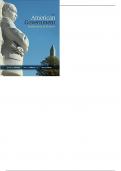Exam (elaborations)
Test Bank For American Government Institutions & Policies 14th Edition by James Q. Wilson
- Course
- Institution
CHAPTER 3 Federalism MULTIPLE CHOICE 1. When the Framers drafted the Constitution, the Antifederalist opposed it primarily on the grounds that the new government a. empowered state governments. b. created a bicameral Congress. c. gave states the power to coin money. d. created a navy. e. ga...
[Show more]



